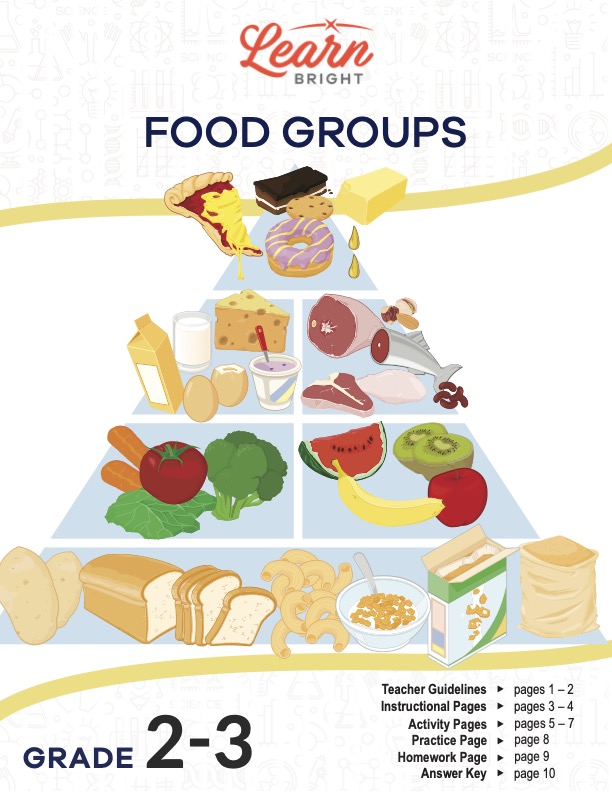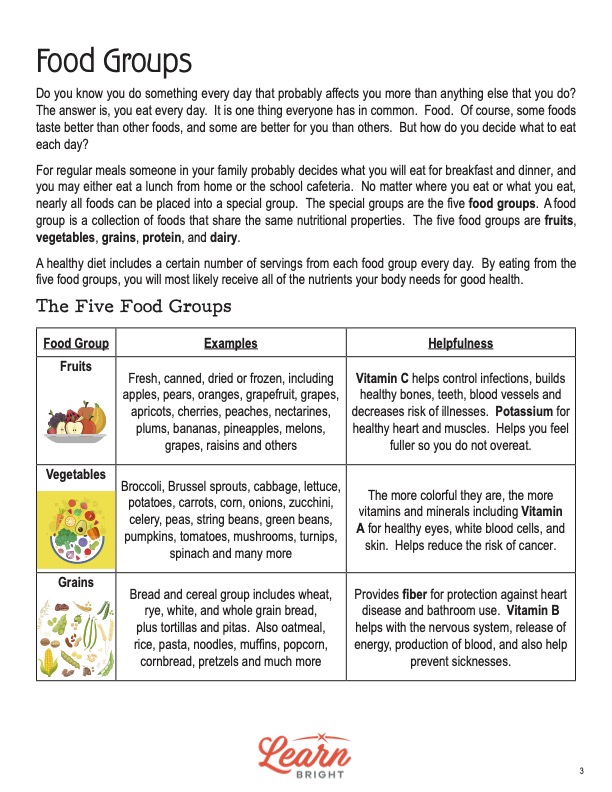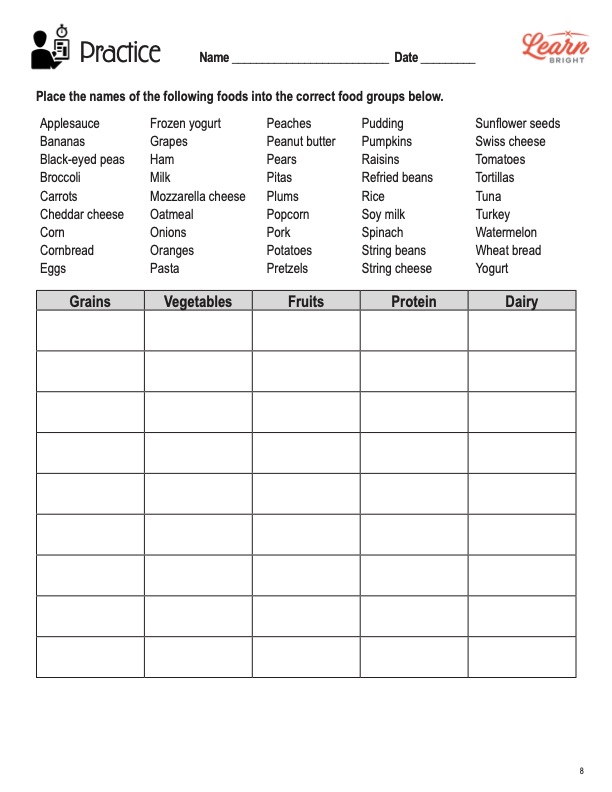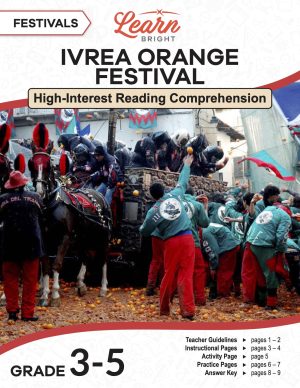Description
What our Food Groups lesson plan includes
Lesson Objectives and Overview: Food Groups teaches students about the types of foods that fall into each of the main five categories. Students will discover why it is important to eat things from each group. They will also learn about the benefits that the five categories provide the body. This lesson is for students in 2nd grade and 3rd grade.
Classroom Procedure
Every lesson plan provides you with a classroom procedure page that outlines a step-by-step guide to follow. You do not have to follow the guide exactly. The guide helps you organize the lesson and details when to hand out worksheets. It also lists information in the yellow box that you might find useful. You will find the lesson objectives, state standards, and number of class sessions the lesson should take to complete in this area. In addition, it describes the supplies you will need as well as what and how you need to prepare beforehand. For this lesson, the only supplies you will need to provide in addition to the handouts are food store flyers, scissors, and glue. You will also need to prepare a few things ahead of time. Obtain enough flyers from a grocery store for each pair of students. You might want to use flyers from multiple stores.
Options for Lesson
There are several suggestions in the “Options for Lesson” section that you could incorporate into your lesson as additional activities or alternate ways to approach aspects of the lesson. A couple suggestions specifically relate to the activity. You may want students to work alone rather than in pairs, for instance. Students could use construction paper to glue their pictures onto so they can fit more food items. Another option is to invite a grocery store manager or a nutritionist to speak to the class about food, the food groups, etc. You could also plan a class meal and have food separated into the proper groups on five different tables. One other idea is to plan a field trip to a local grocery store and have students complete a scavenger hunt to find items from each group.
Teacher Notes
The paragraph on the teacher notes page provides a little extra information or guidance for the lesson. It mentions taking advantage of the many resources available on the subject. Many students may not have a choice in what they eat at home, but this lesson will at least make them aware of the importance of eating healthy. Use the blank lines on this page to write down thoughts you have as you prepare.
FOOD GROUPS LESSON PLAN CONTENT PAGES
What Are Food Groups?
The Food Groups lesson plan contains two content pages. The lesson opens by asking students if they know of something they do every day that most likely affects them more than anything else they do. The answer is eating food. The need for food is something every single person has in common. Some foods taste better than others, and some are better for us than others. What we eat is a decision we make every day.
For the most part, someone in the family probably decides what to eat every day for breakfast and dinner. If school is in session and students don’t bring lunch from home, the cafeteria decides what they will eat. Nearly every food falls into a special category or type. These categories are called food groups. A food group is a collection of foods that share the same nutritional properties. The five main types of food are fruits, vegetables, grains, protein, and dairy.
Students will learn that a healthy diet includes a certain number of servings from each group every day. The reason is that each group provides certain nutrients that the body needs. Eating foods from every group ensures that our bodies will receive all the necessary nutrients we need to maintain good health.
Fruits, Veggies, and Grains
The lesson describes examples and benefits for each group. First is the fruits category. Fruits include cherries, apples, grapes, melons, and oranges. These foods can be fresh, frozen, or dried. For instance, dried grapes are raisins, so raisins fall into the fruit group. The same is true of prunes, which are dried plums.
Fruits contain vitamin C, which helps control infections and build healthy bones, teeth, and blood vessels. They also contain potassium, which contributes to a healthy heart and healthy muscles. In addition, eating fruit helps our bodies feel fuller so we don’t eat too much food.
Vegetables include broccoli, cabbage, zucchini, green beans, mushrooms, spinach, and so much more. The more colorful a vegetable, the more vitamins and minerals it contains, such as vitamin A. Vitamin A helps the eyes, white blood cells, and skin remain healthy. It also helps reduce the risk of cancer.
The foods that fall into the grains category include bread and cereals, tortillas, oatmeal, noodles, popcorn, and pretzels. Grains provide fiber, which is a very important component that helps protect the body against heart disease. Fiber also helps the body’s excretory system and improves digestion. Grains contain vitamin B as well. This vitamin helps with the nervous system, the release of energy, and the production of blood. In addition, vitamin B helps prevent sicknesses.
Protein and Dairy
Students will learn about foods with protein next. People often call the protein group the meat and fish group because it includes meats like chicken, turkey, fish, lobster, and ham. This group also contains eggs, nuts and seeds, and all the different types of beans. That means that peanut butter is also part of the protein group.
Protein helps the body with the formation of bones, muscles, blood, and other tissues. Protein-rich foods contain many vitamins and nutrients, such as vitamin E, iron, and zinc. These components help heal the body and produce energy.
The dairy group includes any food that comes from milk or soy. These foods include (apart from milk), cheese, yogurt, ice cream, and pudding. The most well-known mineral that we associate with dairy foods is calcium. Calcium helps build strong bones and teeth. Dairy also contains vitamin D, which helps the body absorb calcium. It also reduces the risk of certain illnesses and helps our muscles work properly.
Using the Food Groups
The number of different kinds of food in each category is extensive. Most kids need a variety from each group. The lesson provides a list of the groups and the daily recommended amount that students should have at their age. There may always be exceptions, especially when people have allergies or intolerances to certain types of food. In general, this is the list to follow:
- Fruits—2 cups
- Vegetables—2 1/2 cups
- Grains—6 ounces
- Protein—5 1/2 ounces
- Dairy—3 cups
Some foods, especially meals, contain things from multiple groups, such as pizza. Most of the time, a pizza will have cheese, which is a dairy food, and tomatoes from the sauce, which is a vegetable. It might also have pepperoni, which is a meat or protein. Sometimes the pizza has pineapple, a fruit. And the crust of pizza is made from grains.
This is why some pizzas can actually be quite healthy. However, as with all foods, too much or too little of any food is usually unhealthy. Each group has different benefits that contribute to a healthy diet and a healthy body. That is why it is so important to eat foods from all the food groups.
Some foods don’t fall into the five categories, such as candy bars, soda, and other junk food. We should try not to eat these types of food too often because they don’t provide the body very much, if any, nutritional value. Other ways to help our bodies remain healthy include exercising, getting fresh air, and moving around.
FOOD GROUPS LESSON PLAN WORKSHEETS
The Food Groups lesson plan includes three worksheets: an activity worksheet, a practice worksheet, and a homework assignment. These handouts will help solidify students’ grasp of the lesson concepts in different ways. The guidelines on the classroom procedure page outline when to distribute each worksheet to the students.
GROCERY STORE FLYER ACTIVITY WORKSHEET
Students will work in pairs for the activity, but you are welcome to have them work alone or in small groups if you prefer. For the activity, students will review grocery store flyers and cut out the ads for various food items. They will glue the foods into the appropriate boxes on the activity pages. Then they will answer four questions that relate to the ads in the flyer.
SORT THE FOODS PRACTICE WORKSHEET
The practice worksheet provides a list of 45 foods and a table of five columns to represent the five food groups. Students must place the 45 foods into the correct groups in the table. You may or may not allow them to use the content pages for reference.
FOOD GROUPS HOMEWORK ASSIGNMENT
For the homework assignment, students will track what they eat for two days. The worksheet displays two tables, one for each day, with columns and rows to track breakfast, lunch, dinner, and other foods, such as snacks. Students must write which group each food they eat belongs to: grains (G), vegetables (V), fruits (F), protein (P), dairy (D), or more than one (M). They may want help from a family member to fill out the chart.
Worksheet Answer Keys
The last page of the lesson plan is an answer key for the practice worksheet. The answers are in red to make it easy to compare to students’ responses. If you choose to administer the lesson pages to your students via PDF, you will need to save a new file that omits this page. Otherwise, you can simply print out the applicable pages and keep this as reference for yourself when grading assignments.









